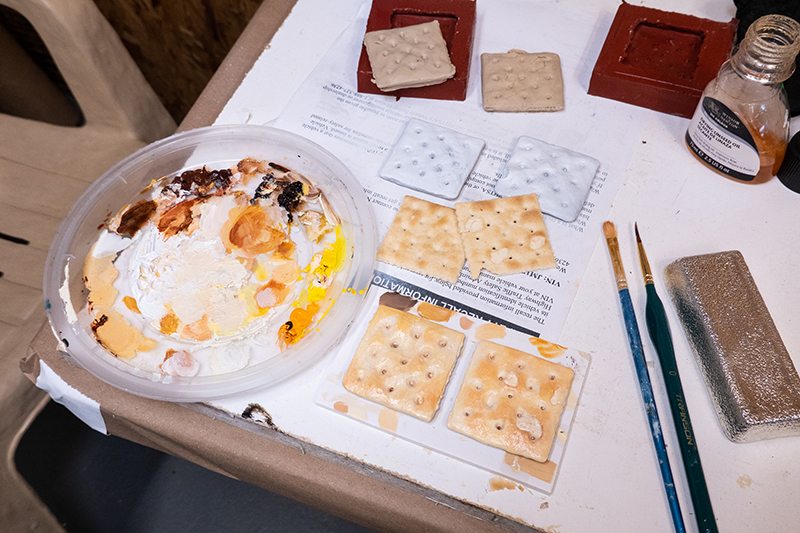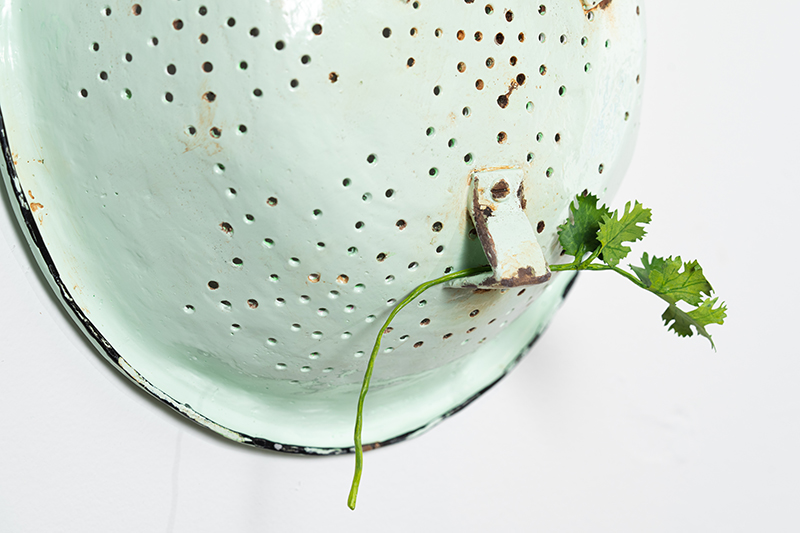The junk drawer, the garage, on the closet shelf with a random assortment of painting supplies. Blue Tape is often found in places of utility. Its purpose is simple yet multifaceted; it keeps areas paint free, it demarcates a spot on the wall or floor, and sometimes, in a pinch, you can use it to wrap a gift. Blue Tape is familiar and unpretentious. A common household workhorse; dependable, accessible, and yet temporary.
Adhesive Tape is U.S. Patent No. 1,760,820. In 1925, Richard Drew, a lab technician at 3M, was on route delivering trial batches of sandpaper to automotive shops when he noticed the need for a tape that would allow painters to easily mask off car parts without stripping existing paint. It needed to be both sturdy and removable. Drew began prototyping a tape using cabinetmaker’s glue and crepe paper. Scotch® Masking Tape was born. Five years later, Drew developed a transparent cellophane tape, and it quickly became a major asset for quick repairs during the Great Depression from book pages to glass windows. It wasn’t until 1988 that 3M’s Scotch Blue Painter’s Tape entered the scene as a handy companion for professional and DIY painters in residential and commercial applications. Blue Tape’s adhesive is a medium tack acrylic compound that can be removed residue-free within 14 days.

In my studio, Blue Tape is the ultimate tool; it demarcates places on the wall for anchoring, it adheres brown paper to my worktable. It helps me hold down a piece of Owens Corning Foamular 150 insulation foam on a Smooth-On Rebound 25 rubber mold so it doesn’t float to the top.
Many of my sculptures replicate domestic items possessing myriad functions—sink sponges, water hoses, bobby pins, colanders. These mimetic moments stem from a desire to pause time, holding a precise and banal action in perpetuity. I use a wide range of materials to explore a personal terrain, unraveling the functions of household items while highlighting nuances in landscapes both interior and exterior. The meticulous care I have for overlooked fragments is extraordinary, some might think unnecessary, but it slows down the viewer’s eye, focusing on familiar metaphors and collective experiences. A paper plate becomes a head, a saltine cracker transforms into a filtering kidney. Each object I fabricate, sculpt, and faux finish attempts to hold the flux of sensuality, vulnerability, and humor tightly together, creating a slippage simultaneously solid and effervescent.
So naturally, I had to find a way to replicate Blue Tape. I needed a material that was thin, paperlike, but strong enough not to tear apart. I turned to a small roll of Tyvek® I had in the studio, which I used previously to make a bouquet of cilantro leaves in 2020. In 1955, a DuPont researcher discovered “white fluff” blowing out of an air vent in an experimental textile lab, obtained a patent for the polyethylene fibers, and now Tyvek® can be found everywhere from construction sites to FedEx envelopes. From
1986-1999 New Zealand used Tyvek® for their driver’s licenses and, in 2011, American Apparel sold a pair of white Tyvek® shorts for $24.

The first challenge is the texture. Blue Tape isn’t smooth like its fellow Scotch® brand Packaging or Magic Tape—it has a subtle, irregular surface, like plant cells under a microscope. Using a jumbo wooden craft stick (a fancy name for a tongue depressor), I score the Tyvek® back and forth, embossing a weave pattern, mimicking Blue Tape’s terrain. Then there is the color—“Blue Tape blue”—a hue married to its material, only found in other examples on my daughter’s Baby Einstein piano or a 7-Eleven Blue Raspberry Slurpee. This isn’t a straight-from-the-tube blue. Cerulean isn’t right and cobalt is too dark. This color matching game is my favorite studio activity. I’ve color matched rust on an I-beam, the yolk of deviled eggs, and the crumble crust of a dump cake. I mix Golden brand Titanium White, Reeves brand Ultramarine Blue Gouache, and a touch of Blue Lake Gouache with a little water. Real Blue Tape is almost translucent, like when you peel off a piece of sunburned skin, so I brush my blue wash mix on the Tyvek® with a fan brush—a happy little bush à la Bob Ross. When I’m done, I have a few scraps of Blue Tape that will last forever—real Blue Tape tears easily, my forever Blue Tape must be cut with a box cutter blade.

I glue my fragments of forever Blue Tape to other sculptures in my studio using archival LINECO Neutral pH Adhesive. One piece placed on a gypsum colander, a few positioned on a cast concrete fence post, and one on my studio wall, each blending in with their real counterparts. My forever Blue Tape is quiet, a copy-paste of the real and might even be mistaken for the thing you will use, peel off, and throw away within 14 days.
IMAGES: All Images courtesy of the artist
TOP: Tamara Johnson (b. 1984). Cracker (in process), 2023. Pewter, oil-based paint, 2 x 2 x 1/4 inches (5 x 5 x .6 cm).
MIDDLE: Tamara Johnson (b. 1984). Colander with Cilantro, 2021. Hydrocal gypsum, fiberglass, wire, Tyvek, enamel and acrylic paint. 4 x 9 1/2 x 9 1/2 inches (10 x 24 x 24 cm)
BOTTOM LEFT: Tamara Johnson (b. 1984). Colander with Sponge and Clip, 2021. Hydrocal gypsum, silver leaf, resin, fiberglass, acrylic paint. 4 x 12 x 10 inches (10 x 30.4 x 25.4 cm)
BOTTOM MIDDLE: Tamara Johnson (b. 1984). Rock City Mug with Cilantro Bouquet, 2020. PVC pipe, rope, resin, woven aluminum wire, pigmented resin, epoxy putty. 52 x 35 x 2 inches (132 x 88.9 x 5 cm). Part of solo exhibition, How to fold a fitted sheet, ex ovo gallery, Dallas, Texas
BOTTOM RIGHT: Forever Blue Tape (in studio). Tyvek paper, gouache, acrylic. Dimensions variedgv